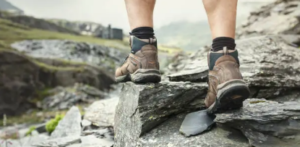Men’s hiking shoes provide the ideal combination of comfort and versatility for outdoor adventures of any kind, be they backpacking, thru-hiking, campsite walking or even running errands after your hike. The mens hiking shoes will ensure that your journey goes as smoothly as possible!
 Always choose to size up when wearing thicker socks, particularly if you plan on backpacking and thru-hiking for several miles at once.
Always choose to size up when wearing thicker socks, particularly if you plan on backpacking and thru-hiking for several miles at once.
Comfort
Comfort in hiking shoes is of utmost importance; fitting them correctly to prevent blisters, banged-up toenails, and other painful conditions is paramount. Furthermore, lightweight is important – every ounce saved lifting your feet helps extend the trek further!
Some mens hiking shoes use a rocker bottom design to reduce pressure on the foot when walking, thereby improving forward momentum and helping alleviate strain on feet, ankles, knees and backs. This type of shoe may prove especially helpful if you experience lower back pain or are carrying heavy loads.
Hiking shoes should provide maximum comfort. Consider selecting ones with a padded tongue and insole for optimal cushioning, as well as those featuring Ghillie lacing; this form of lacing uses a crosshatch pattern of holes to keep feet secure in their position.
Outsole lugs of hiking shoes are designed to grip rugged terrain and rough surfaces like boulders, sand, and gravel. Certain lugs may feature more aggressive or deep designs to give a firm grip on slippery or loose trails; however, more aggressive and deeper designs wear down faster, leading to decreased durability and reduced lifespan in your hiking shoes.
Durability
The ideal mens hiking shoes and boots are built for adventures across rugged terrain. A durable upper made from leather or synthetic materials can withstand rough use while resisting abrasion, while breathable nylon mesh allows heat to escape and sweat to evaporate. Some manufacturers even provide hybrid materials like Nubuck leather with its brushed finish and suede-like feel, which is lighter yet more flexible than full-grain leather while remaining more durable than traditional nylon mesh – often found on heavier-duty hiking boots.
Hiking shoes are designed to be more rugged and resilient than trail running shoes, as they’re intended for longer hikes and backpacking expeditions. Their stiffer construction, protective toe caps and synthetic/leather uppers hold up well against rugged terrain than running shoes do, as do their deeper lugs for added grip on slippery surfaces such as mud or loose talus – especially useful when hiking above treeline where rocks may fall more often!
Traction
Day hikers and backpackers looking for lightweight loads over defined trails usually opt for hiking shoes with low-cut cuffs that provide both agility and support, compared to boots that take more time to break in, dry quickly, stiffer construction (such as leather/synthetic combination uppers with rubber toe caps for protection) or stiffer construction with extra durability features like rubber toe caps for protection. For backcountry enthusiasts that require added stability or additional protection, we suggest looking at approach shoes such as Salomon X Ultra 4 GTX, which provide more stability as well as extra stability and protection.
Style
Hiking shoes typically last up to 1,000 miles before you should replace them; however, sooner rather than later is recommended. When the heel cups wear out, the toe box becomes compressed, or the laces loosen or come undone, it’s time for a new pair. Furthermore, midsoles that no longer provide adequate cushioning or support or develop hot spots and blisters after long walks on rough trails must also be addressed promptly with new pairs.
For optimal hiking success, the right hiking shoes must match the type of terrain you will encounter on your hikes. For instance, if you spend most of your time traversing narrow and rocky trails, consider investing in approach shoes with sticky rubber soles that enable climbing up small rocks features. Shoes designed with rocker bottoms may also help alleviate lower body joint stress by relieving the strain placed upon lower body joints and feet, according to Roach.